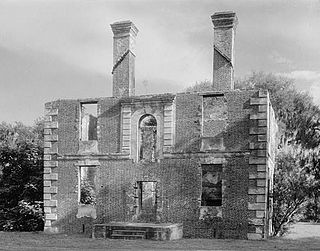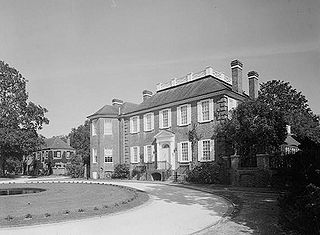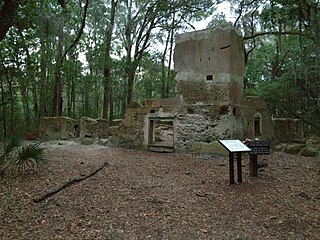
Drayton Hall is an 18th-century plantation house located on the Ashley River about 15 miles (24 km) northwest of Charleston, South Carolina, and directly across the Ashley River from North Charleston, west of the Ashley in the Lowcountry. An example of Palladian architecture in North America and the only plantation house on the Ashley River to survive intact through both the Revolutionary and Civil wars, it is a National Historic Landmark.

The Judah P. Benjamin Confederate Memorial at Gamble Plantation Historic State Park, also known as the Gamble Mansion or Gamble Plantation, is a Florida State Park, located in Ellenton, Florida, on 37th Avenue East and US 301. It is home to the Florida Division United Daughters of the Confederacy (UDC).

The Paul Hamilton House, commonly referred to as the Brick House Ruins, is the ruin of a 1725 plantation house on Edisto Island, South Carolina, that burned in 1929. It was designated a National Historic Landmark in 1970 for the unusual architecture of the surviving walls, which is partly based on French Huguenot architecture of the period.

Hampton Plantation, also known as Hampton Plantation House and Hampton Plantation State Historic Site, is a historic plantation, now a state historic site, north of McClellanville, South Carolina. The plantation was established in 1735, and its main house exhibits one of the earliest known examples in the United States of a temple front in domestic architecture. It is also one of the state's finest examples of a wood frame Georgian plantation house. It was declared a National Historic Landmark in 1970.
Frogmore is an unincorporated community on St. Helena Island in Beaufort County, South Carolina, United States, along U.S. Route 21.

Catherineberg Sugar Mill Ruins is an historic site located in the Virgin Islands National Park, east of Cruz Bay on Saint John, U.S. Virgin Islands. The ruins are an example of an 18th-century sugar and rum factory.

Cinnamon Bay Plantation is an approximately 300-acre (1.2 km2) property situated on the north central coast of Saint John in the United States Virgin Islands adjacent to Cinnamon Bay. The land, part of Virgin Islands National Park, was added to the United States National Register of Historic Places on July 11, 1978. Archaeological excavations of the land document ceremonial activity of the Taínos, as well as historic remains of plantation ruins.

Mary Point Estate is a historic property located on the north coast of Saint John, United States Virgin Islands on Mary's Point. The plantation was added to the U.S. National Register of Historic Places on May 22, 1978.

The Fenwick Hall, which is also known as Fenwick Castle, is a plantation house built about 1730 on Johns Island, South Carolina, across the Stono River from James Island and Charleston. It is located between River Road and Penneys Creek. It was named to the National Register of Historic Places on February 23, 1972.
Sion Hill is a settlement on the island of Saint Croix, in the United States Virgin Islands.

Estate Little Princess is a historic plantation site located northwest of Christiansted in Saint Croix, U.S. Virgin Islands. It was first owned by governor Frederik Moth in 1738 and rests on 25 acres of land. As of 2011 the estate is under ownership of The Nature Conservancy and serves as headquarters for the Eastern Caribbean/Virgin Islands programs. The property has been turned into a nature preserve and historical tours are given as well. The site was listed on the National Register of Historic Places on June 9, 1980.

Stoney-Baynard Plantation on Hilton Head Island, SC was listed on the National Register of Historic Places in 1994. The listing included one contributing site on 6 acres (2.4 ha).

Sams Plantation Complex Tabby Ruins is a historic plantation complex and archaeological site located at Frogmore, Beaufort County, South Carolina. The site, possibly built upon and occupied well before 1783. It includes the ruins and/or archaeological remains of at least 12 tabby structures. They include the main plantation house, a rectangular enclosure consisting of tabby walls, a large tabby kitchen, and five tabby slave quarters. Also on the property were a variety of tabby dependencies including a barn/stable, a smoke house or blade house, a well/dairy house, and a well. The property also includes the Sams family cemetery and Episcopal chapel enclosed by high tabby walls. Other structures include possibly an overseer's house, a granary/mill, and a tabby cotton house. During and subsequent to the American Civil War the Sams Tabby Complex was occupied by freedman. Following the Civil War the plantation house was destroyed by hurricanes.

Bordeaux, also known as Estate Bordeaux, is a historic former sugar plantation located on the West End of Saint Thomas, U.S. Virgin Islands. It was listed on the U.S. National Register of Historic Places in 1978. The listing included three contributing buildings and a contributing structure.

Fortsberg, a fortification overlooking Coral Bay in Saint John, U.S. Virgin Islands also known as Frederiksvaern, was built in 1760. It was listed on the National Register of Historic Places in 1976.

The Estate Carolina Sugar Plantation near Coral Bay on Saint John, U.S. Virgin Islands is a historic sugar plantation and later rum distillery.
Brown Bay is a bay and a former sugar cane and cotton plantation in the Virgin Islands National Park on the island of Saint John, U.S. Virgin Islands. It is on the north shore of eastern end of the island, north of the settlement of Palestina.
Liever Marches Bay is a shallow bight on the north shore of the island of St. John, U.S. Virgin Islands, just east of Brown Bay, towards the eastern end of the island. It has a 450 feet (140 m) shingle beach.
Estate La Reine, near Christiansted on Saint Croix in the U.S. Virgin Islands, dates from around 1750. It was listed on the National Register of Historic Places in 1980. The listing included three contributing buildings, two contributing structures, and a contributing site.















